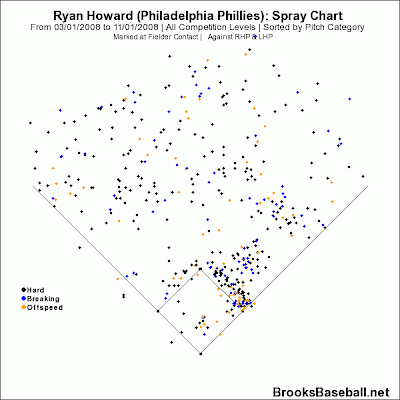2008: 28 years old, 14 Rbat, .292 ISO, 15.6 Whiff %:
Pitchers were pitching away from him, and it was the slowest and lowest pitches he was swinging and missing at, nothing real unusual for a power hitter.
A lot of "hard" pitches hit to the outfield the other way, pulling a lot of breaking and offspeed stuff (with some hard stuff as well).
2009: 29 years old, 33 Rbat, .292 ISO, 15.7 Whiff %
The whiffs are even slower and lower, with the runs being higher in the zone, but a little slower. This is the best year we are looking at, at least by Rbat.
Other than just a few balls just hit much further, the home run chart seems the same. It seems that there were less fastballs taken the other way, with more breaking pitches hit that way.
2010: 30 years old, 19 Rbat, .229 ISO, 14.6 whiff %
There were less whiffs, but they are basically the same in velocity and location. Even though his power was lower, he was more of a high ball hitter that season.
2011: 31 years old, 17 Rbat, .235 ISO, 14.5 whiff %
For the second straight year, he traded some power for less whiffs and had another good season. The whiffs this season were a little more, and a little harder. It still broke down where the harder pitchers were the ones he hit and more success on while the slower ones were the ones he missed.
It seems he pulled the ball a little better than he did in 2010. A pretty balanced outfield spray chart
2012: 32 years old, -6 Rbat, .204 ISO, 15.2 whiff %
Whether it was the ankle, age, or something else, this is when Howard really regressed. 2008-2011 Howard was roughly the same hitter in value, even though he did it differently in 2010-2011 than he did in 2008-2009. His whiffs were harder this year again, though everything was harder as there were just more pitchers that threw harder, and this time they were further away. The no out plays were the closest to the center of the plate on average than anything we had seen so far. However, the runs returned to being the highest, just like in 2008-2009, though everything shifted down. He missed more low pitches, and hit less high pitches.
2013: 33 years old, 3 Rbat, .201 ISO, 16.5 whiff %
Thanks to a BABIP spike, Howard is an above average hitter again, but his power and ability to make contact is even worse (meaning he will probably regress and may be even worse than in 2012). He is back to being a high ball hitter, but pitchers are less scared to come inside than ever before, as his average pitch seen is closer to the center of the plate than ever. His regression on pitches on the inside part of the plate is also showed by the whiffs being closer to the center of the plate than ever before.
He hasn't been hitting really any balls between the right-fielder and center-fielder, and most of his pulled balls are not hard pitches. Most of those are hit the other way (along with breaking pitches, which makes sense, as most breaking pitches are thrown to the glove side of the plate by pitchers that have the platoon advantage, meaning they would be on the outside to Howard or any hitter).
The problem isn't up and in, as Howard still has power up there, hitting a couple of homers on up and in pitches in the zone (he only had 2 in that zone, zone 3 according to Baseball Savant, in 2008). The problem is low and in (zone 9). He has 19 swinging strikes on pitches low and in so far in 2013. In 2008, he had 15 in that zone in a much bigger sample size.
Since 2008, he has 97 whiffs on pitches 95 MPH or over (16.1%). 26 of them have come in 2012 or 2013, even though his 2012 and 2013 seasons represent just 18.3 % of pitches seen since 2008 for Howard. There has been a clear bat speed regression for Howard, and this season, it is letting pitchers come more inside.












No comments:
Post a Comment